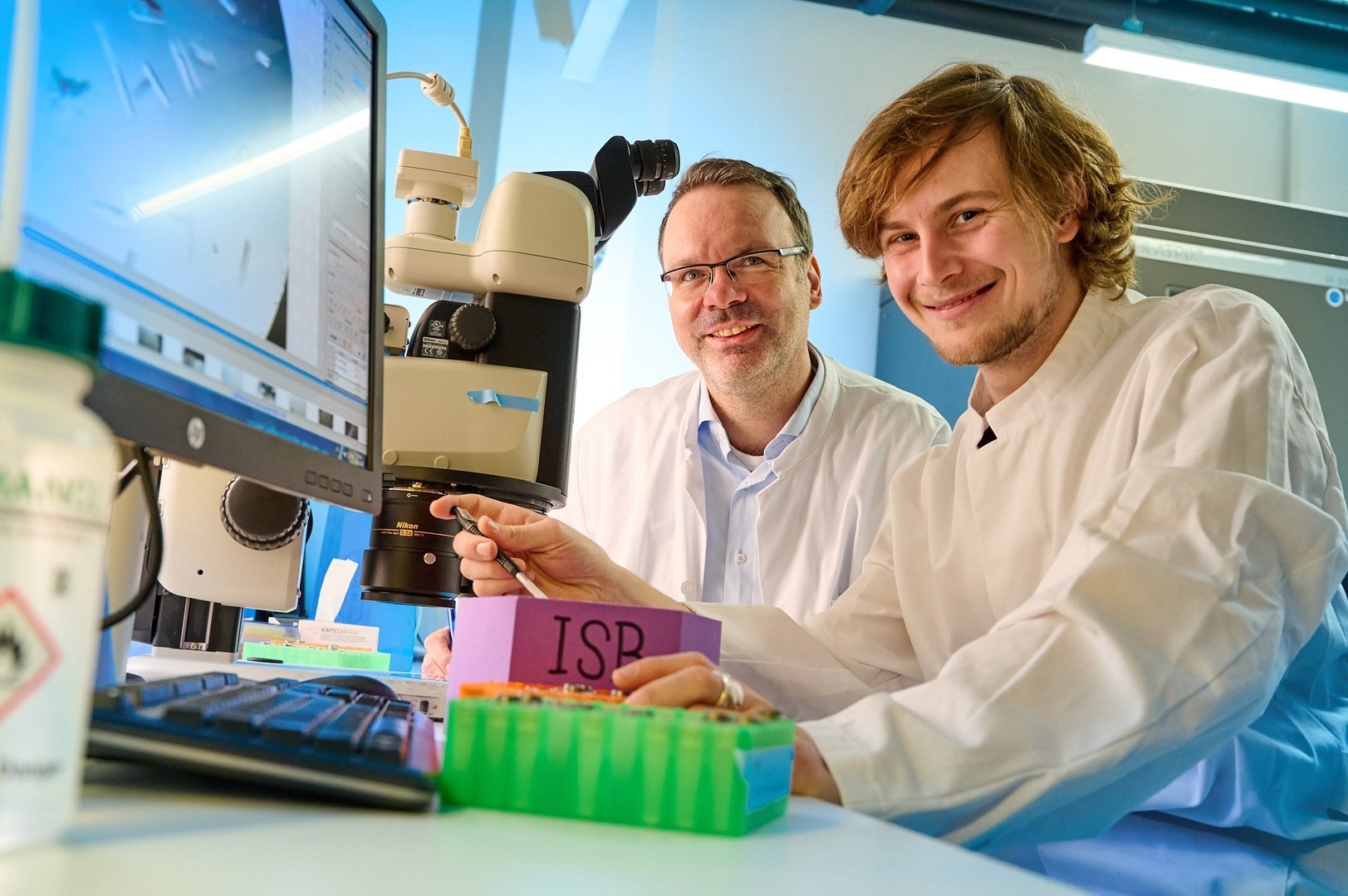Many years earlier, the CRISPR/Cas9 gene scissors have been making a sensation in science and medicine. This new tool of molecular biology consists of its origins in an ancient bacterial immune system.
 In the lab: (from the left) PD Dr Gregor Hagelueken, group leader at the Institute of Structural Biology at UKB, and Niels Schneberger, doctoral student at UKB’s Institute of Structural Biology, are freezing protein crystals. Image Credit: University Hospital Bonn (UKB)/J.F. Saba
In the lab: (from the left) PD Dr Gregor Hagelueken, group leader at the Institute of Structural Biology at UKB, and Niels Schneberger, doctoral student at UKB’s Institute of Structural Biology, are freezing protein crystals. Image Credit: University Hospital Bonn (UKB)/J.F. Saba
It safeguards bacteria from attack by alleged phages, which are the viruses that infect bacteria. Scientists from the Medical Faculty of the University of Bonn and the University Hospital Bonn (UKB), in partnership with the partner the University of St Andrews in Scotland and the European Molecular Biology Laboratory in Hamburg, have currently found a new function of the gene scissors.
The study was reported in the scientific journal Nature.
Since time immemorial, bacteria and phages have been occupied in a life-and-death struggle on Earth. When an attacking phage tends to inject its genetic material into a bacterium, it is pushed to produce new phages, which in return tend to infect more bacteria.
Few bacteria have developed the CRISPR system in response. With this bacterial immune system, the phage genetic material has been identified and ruined.
Simultaneously, the consecutive fragments are combined into the bacterium’s genome. This makes a type of library that the CRISPR immune system has the potential to access again and again and is hence armed for future attacks.
Besides, it was discovered that alleged type III variants of the gene scissors generate small signal molecules. With the help of such small molecules, the bacteria get switched on to a complicated emergency plan. This guarantees that a virus can be fought optimally and on a broad front.
Currently, scientists at the Institute of Structural Biology at the University Hospital Bonn (UKB) and the Medical Faculty of the University of Bonn have examined how these functions in collaboration with researchers from the partner the University of St Andrews in Scotland and the European Molecular Biology Laboratory in Hamburg.
The research group found out that the small signal molecules bind, among other things, to a protein known as CalpL, which thereby turns out to be an active “protease.” These are enzymes that tend to cleave proteins and hence work as protein scissors.
Proteases are also used in the human immune system to pass on information at high speed.”
Niels Schneberger, Study First Author and Doctoral Student, Institute of Structural Biology, University Hospital Bonn
Eventually, the scientists also discovered the target of their newly found protein scissors. It cuts a small protein molecule known as CalpT, which serves as a safety latch for CalpS, a third protein molecule
CalpS is a very well-guarded protein that is released by the whole mechanism. It's going to bring the transcription machinery to specific genes, switching the metabolism of the bacterium to defense. We are very curious of knowing what those genes are”
Christophe Rouillon, Study First Author and Visiting Scientist, Institute of Structural Biology, University Hospital Bonn
With the breakthrough of this complex signaling cascade, scientists have currently unraveled a whole new idea of CRISPR systems.
Also, the team stated that the great thing regarding CRISPR systems is that they can be very easily reprogrammed for medical and biotechnological causes. With the help of CRISPR, DNA can be particularly altered—that is, genes or full blocks of genes could be inserted or excised.
A few diseases, like spinal muscular atrophy (SMA), which leads to nerve paralysis, could be treated earlier now with the availability of gene scissors.
With this CRISPR-activated protein scissors, there is now a brand-new tool in the toolbox of molecular biology. And perhaps this will allow CRISPR to be used in even more versatile ways in the future.”
Dr Gregor Hagelueken, PD, Group Leader, Institute of Structural Biology, University Hospital Bonn
Hagelueken is a member of the Transdisciplinary Research Area “Life and Health” at the University of Bonn.
Source:
Journal reference:
Rouillon, C., et al. (2022) Antiviral signaling by a cyclic nucleotide activated CRISPR protease. Nature. https://doi.org/10.1038/s41586-022-05571-7.